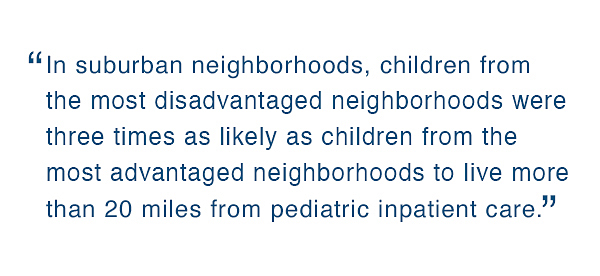DataMatters - November 2023 Edition Email

DATE: November 30, 2023

Happy holidays from CHIA! We hope that our readers had an enjoyable Thanksgiving with family and friends.
Since we last released DataMatters, CHIA published its first report on pediatric readmissions in Massachusetts acute care hospitals. This report provides an important baseline for the pediatric population in Massachusetts for future examination, with analyses of observed pediatric readmissions rates by patient demographics, payer type, and diagnoses, in addition to risk-adjusted rates by acute care hospitals and hospital types for state fiscal years (SFY) 2017 through 2022.
CHIA also released its latest report on primary care expenditures in the Commonwealth. We provide more detail on this report and CHIA’s other reporting initiatives related to Massachusetts primary care, in the “News You Can Use” section below.
In the “Data User Profile” section, we interview researchers from Boston Children’s Hospital and Harvard Medical School on their latest study using CHIA’s Case Mix data, exploring the relationship between neighborhood poverty and geographic access to pediatric inpatient care. We also include information on upcoming events related to health care that may be of interest to you.
We hope that you enjoy this newsletter and learn something new. If there’s something you liked or if you have suggestions for improvement, we welcome your feedback at newsletter@chiamass.gov.
News You Can Use
Over the past few years CHIA has increased its reporting on the state of primary care in Massachusetts, from examining spending trends to exploring the quality of care available to Commonwealth residents.
In early October we released our second report on primary care expenditures in Massachusetts. Investments in primary care can meaningfully influence patient outcomes and are often associated with lower health care costs and higher quality care. To better understand the system-wide investments in these areas, CHIA launched this report series to examine primary care expenditures. This report focuses on spending for primary care services for members enrolled in private commercial, Medicaid MCO/ACO-A, and Medicare Advantage plans for calendar year (CY) 2021. New to this year’s report, primary care expenditures are additionally reported at the provider and payer level to enhance transparency and support data driven policymaking.
Key Findings from the Primary Care Expenditures Report:
- In 2021, spending on primary care represented 6.9% of total spending for commercial members, 6.0% for Medicaid MCO/ACO-A members, and 4.2% for members enrolled in Medicare Advantage plans.
- Commercial primary care per member per month (PMPM) spending was $41 in 2021. Medicare Advantage members had slightly higher primary care spending PMPM at $44, and MassHealth members enrolled in MCO/ACO-A plans had lower primary care spending PMPM at $31.
- Across all insurance categories, a majority of primary care spending was comprised of office visits for general evaluation and management services.
In January 2023, we also published our first-ever dashboard of metrics to monitor the health of primary care in the Commonwealth, in collaboration with Massachusetts Health Quality Partners (MHQP). This primary care dashboard tracks the key areas of finance, capacity, performance, and equity.
CHIA and MHQP developed this dashboard to create a factual foundation to support policy initiatives. Tracking the health of primary care is critical to identify areas that need strengthening and further monitoring.
We plan to publish the next installment of the primary care dashboard in early 2024.
These reporting series on the Massachusetts primary care system are part of a larger effort by CHIA to offer policymakers and industry leaders valuable data that can be used to inform and track system-wide reforms and investments in primary care across the Commonwealth.
Data User Profile
Every edition of DataMatters includes an interview with a user of CHIA data. This time we feature an interview with Dr. Lauren Brown, Dr. Urbano L. França, and Dr. Michael L. McManus from Boston Children’s Hospital and Harvard Medical School, on their article Neighborhood Poverty and Distance to Pediatric Hospital Care. This study was conducted using CHIA’s Case Mix datasets, including the Hospital Inpatient Discharge Data (HIDD), Outpatient Observation Data (OOD), and Emergency Department Data (EDD).
The researchers sought to explore the relationship between neighborhood poverty and geographic access to pediatric inpatient care.
CHIA is grateful to the authors for their participation in this month’s newsletter.
What was your research question? Why did you choose that question?
For this study, we set out to describe the relationship between neighborhood poverty and geographic access to pediatric inpatient care.
This interest arose from our prior research, which has shown that pediatric hospital care has become increasingly consolidated over the past several decades. We have found that even basic pediatric conditions are increasingly triaged to tertiary centers for routine care. Pediatric patients with common conditions such as asthma are often transferred from their initial location to tertiary centers, regardless of whether or not they require higher level services.
We feel it is important to understand how this phenomenon differentially affects disadvantaged populations. In a prior study we saw that geographic distances to critical care units were larger for patients from lower socioeconomic neighborhoods. Given the consolidation of routine care into tertiary centers, we hypothesized that a relationship may also exist between socioeconomic status (SES) and geographic access to general capable pediatric hospital care.
Which CHIA data do you use?
In this project, we used the 2017 CHIA’s Case Mix hospital datasets (Inpatient, Outpatient Observation, and Outpatient Emergency Department).
These three datasets provide us with all the information necessary to find capable hospitals using the Pediatric Hospital Capability Index, a metric designed by our group to evaluate the capabilities of different hospitals to provide definitive inpatient care to children. As a matter of fact, we had the opportunity to discuss the details of this metric a few years ago in one of the CHIA Data User Workgroup meetings.
Besides being crucial to define and discover capable pediatric hospitals, the CHIA datasets also allowed us to geographically locate these centers, a fundamental part in evaluating geographic access to care of the different neighborhoods.
What was your experience using CHIA data?
The careful process of data collection and curation made by CHIA has been fundamental for the research done by our group. The detailed documentation of these datasets available on the CHIA website greatly facilitated the research process and allowed us to align the information on these datasets with other State datasets obtained directly from other states and from the Healthcare Cost and Utilization Project from the Agency for Healthcare Research and Quality (HCUP-AHRQ).
Apart from the detailed documentation, we benefited greatly from the monthly meetings of the CHIA Data User Workgroup, where clarifying questions can be asked, and the subtleties of the dataset can be better understood.
Please briefly describe your research and key findings.
We performed a retrospective, cross-sectional study looking at distance to capable pediatric hospital care by neighborhood Area Deprivation Index (ADI) in 17 states. The ADI is a measure of neighborhood disadvantage that has been validated down to the Census block group level, using data from the American Community Survey. In addition to the 2017-18 hospital and demographic data, we used geographic data from the 2010 census.
We found that median distance to pediatric hospital care increased linearly with poverty across ADI national deciles. The nearest hospital admitted children in 51.17% (7,927) of advantaged neighborhoods, versus only 26.02% (3,729) of disadvantaged neighborhoods.
This association between poverty and median distance to care was observed in rural, suburban, and urban census block groups.
 [In suburban neighborhoods, children from the most disadvantaged neighborhoods were three times as likely as children from the most advantaged neighborhoods to live more than 20 miles from pediatric inpatient care.]
[In suburban neighborhoods, children from the most disadvantaged neighborhoods were three times as likely as children from the most advantaged neighborhoods to live more than 20 miles from pediatric inpatient care.]
Which findings were particularly interesting or surprising for you?
At the same time that pediatric hospital care has been consolidating within large—often urban—centers, childhood poverty has been pushed from the cities to the suburbs throughout much of the country. Because of this, we were particularly interested in how SES and distance to hospital care were related for children living in suburban census block groups. We found that in suburban neighborhoods, children from the most disadvantaged neighborhoods were 3 times as likely as children from the most advantaged neighborhoods to live more than 20 miles from pediatric inpatient care (27.85%, 456,533 of children from bottom quintile neighborhoods vs 9.24%, 259,787 of children from top quintile neighborhoods).
What "takeaway" information would you like to highlight from your research and/or experience using our data?
Our research highlights the unintended consequences that can occur when shifting demographics and shifting hospital systems collide. Using the CHIA database, we were able to elucidate a disparity in geographic access to care at the population level and highlight potential weaknesses in our current system of pediatric hospital care.
Publications and Data Releases
Primary Care Expenditures in Massachusetts
October 2023
In early October, CHIA published its latest report on primary care spending in Massachusetts for CY 2021. This report offers policymakers and industry leaders valuable data that can be used to inform and track system-wide reforms and investments in these essential services. New to this year’s report, primary care expenditures are reported at the provider and payer level. See more detail and key findings in the “News You Can Use” section above.
Hospital Readmissions Profiles
October 2023
The Hospital Readmissions Profiles series offers a graphical report for each acute care hospital in the Commonwealth, including an interactive dashboard, for FY 2021. These profiles provide more in-depth readmission statistics for each hospital broken out by several factors and presented in the context of the statewide figures.
New! Pediatric Readmissions Report
October 2023
CHIA released its first-ever report on pediatric all-payer readmissions in the Commonwealth. This report presents pediatric readmissions rates by patient demographics, payer type, and diagnoses.
New! 2023 Quality Measure Catalog
October 2023
CHIA earlier this month published the results from the Quality Measure Catalog survey, which assesses Massachusetts payer adherence to a set of high-priority quality measures recommended for global budget-based risk contracts by the EOHHS Quality Measure Alignment Taskforce.
New! Massachusetts Acute Care Hospital Emergency Department Data and Hospital Inpatient Discharge Data (Case Mix), Quarterly Update
November 2023
Today, CHIA published its latest interactive dashboards on emergency department (ED) visits and hospital inpatient discharge data (HIDD). These quarterly updates shows trends revealed by the data from October 2018 – June 2023. Quarterly reports are based on interim data and are updated as more complete information becomes available.
Upcoming Events and Resources
Events and announcements of interest to our community, organized by CHIA, our data partners, and others
CHIA Data User Workgroups
Tuesday, December 5, 2023, 3:00 PM
These ongoing meetings are designed for data users and other interested parties to connect with CHIA to discuss analytical techniques and best practices in research using CHIA's MA APCD and Case Mix databases. The next virtual workgroup meeting will be on Tuesday, December 5, 2023, at 3:00 PM. For more information including past presentations and user support materials, visit the information page. To learn more about CHIA data, please visit https://www.chiamass.gov/chia-data/.
AcademyHealth & National Institutes of Health 16th Annual Conference on the Science of Dissemination and Implementation of Health: Raising Expectations for D&I Science: Challenges and Opportunities
Monday, December 10 – Wednesday, December 13, 2023
Arlington, VA
The 16th annual conference will convene a growing network of peers in Washington, D.C. to explore the latest innovations in dissemination and implementation science to ensure that evidence is used to inform decisions that will improve the health of individuals and communities. This year's in-person conference will concentrate on capitalizing on methodological progress while also focusing attention on areas needing growth. Registration details are available here.
Massachusetts Health Policy Commission Board Meeting
Wednesday, December 13, 2023, 12:00 PM
The HPC’s 11-member Board meets approximately every six weeks throughout the year to review staff- (or guest)- presented overviews of the agency’s major workstreams, and other topics related to health care cost containment and reform. Major reports, statutory regulations, and publications are authorized by a majority vote at these meetings.
CHIA Oversight Council Meeting
Thursday, January 25, 2024, 2:00 PM
CHIA’s appointed Oversight Council meets quarterly to discuss agency priorities and agenda-setting. The next meeting is scheduled for Thursday, January 25, 2024 2:00 p.m. and will stream live on CHIA’s YouTube channel.
The Massachusetts Health & Hospital Association (MHA) Annual Meeting
January 25-26, 2024
Registration is open for MHA's 87th Annual Meeting on Thursday and Friday, January 25-26, 2024, at the Westin Copley Place in Boston. Early bird pricing is available until December 15. Among the many timely panels and discussions will be one featuring Secretary Yvonne Hao from the Executive Office of Housing and Economic Development, Secretary Kate Walsh from the Executive Office of Health and Human Services, and Secretary Lauren Jones from the Executive Office of Labor and Workforce Development.
Massachusetts Association of Health Plans (MAHP) 2024 Annual Conference
SAVE THE DATE! Friday, November 15, 2024
MAHP will be holding next year's conference at the Seaport Hotel on November 15th. Individual registrations will open in June. Please reach out to Ann Chamberlin at chamberlin@mahp.com to get information on sponsorship opportunities.
Join Our Team
A selection of open positions at CHIA. Please feel free to share broadly with your network. Follow CHIA on LinkedIn for more regular updates.
Associate Manger of Health Services Pricing
Health Services Pricing Team
Director of Cloud Computing
Data Operations and Technology Team
CENTER FOR HEALTH INFORMATION AND ANALYSIS
www.chiamass.gov

